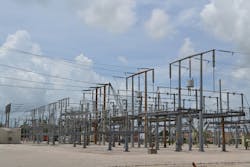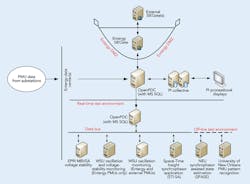The Intelligent Grid Enters a New Dimension
Over the last 100-plus years, the U.S. electric grid has evolved and grown into what is regarded today as one of the country’s most critical infrastructures. The grid crisscrosses the United States. It directly and indirectly touches all aspects of American lives. It is the largest machine in the world. Through recent synchrophasor technology implementation, the electric utility industry can now begin to drive toward greater production diversity and gain a deeper understanding of the grid’s multifaceted nature.
Smart Grid Investment Grant
At Entergy, synchrophasor — also known as phasor measurement unit (PMU) — work began in the late 1990s. In 2010, Entergy Services Inc. was awarded a Department of Energy (DOE) Smart Grid Investment Grant (SGIG) for the refurbishment and expansion of the utility’s existing synchrophasor system. The five-year project includes the installation and implementation of PMUs, global positioning satellite clocks, substation computers and secure phasor cabinets. The project also includes state-of-the-art analytics, secure information exchange gateways, open phasor data concentrators (openPDCs) and a Space-Time Insight synchrophasor application for wide-area visualization of the grid.
In the first three years of the project, the focus was on installation and implementation of equipment and software. Over the last two years, work has been dedicated to monitoring and control of the end-to-end PMU architecture, including architecture testing, analytic model validation, device calibration, benchmarking of system metrics and training of Entergy personnel.
Phasor Gateway/SIEGate
The ability to exchange real-time PMU data in a secure and reliable manner with other utilities and system operators is important to understanding the wide-area condition of the grid. To that end, the North American SynchroPhasor Initiative (NASPI) issued the conceptual definition of a phasor gateway as provided by the NASPInet specification.
As part of the Entergy project, the Grid Protection Alliance and the University of Illinois at Urbana–Champaign developed a design specification for Entergy’s phasor gateway (EntergyPG) with the NASPInet specification as a basis. The requirements and approach resulted in creation of the EntergyPG and subsequently SIEGate, which provides secure communication of real-time synchrophasor information with multiple gateways external to the security perimeter and transfers Entergy phasor measurements to and from the internal openPDC to the security perimeter.
Open Phasor Data Concentrator
The openPDC contains a complete set of components for the management, time alignment, distribution and integration of phasor data within Entergy’s PMU architecture. In many respects, the openPDC is the heart of the architecture collecting, sending, aligning and streaming of Entergy’s PMU data to the analytics, visualizations, historians, gateways and publish/subscribe services in real time.
The platform for the openPDC, Grid Protection Alliance’s Grid Solutions Framework (GSF), is also being used by other Entergy PMU project contractors such as the Electric Power Research Institute (EPRI) and Washington State University (WSU) as the foundation for their analytic tools. Using the GSF, these analytic providers are able to focus on implementation of solutions as the GSF manages the input of streaming synchrophasor data and the output of analytic results. Overall, the openPDC is a flexible platform for processing high-speed, time-series data that can adapt with the evolving PMU technology to provide a future-proof phasor data architecture.
Analytic Tools
Voltage-stability analysis is a key function in system operation to help operators foresee the next critical scenarios that may cause systemwide voltage-instability problems. Voltage-stability programs provide operators with margins in terms of the real and reactive power that can flow over a given path before instability occurs, which can cascade and lead to widespread blackouts. Currently, voltage-stability analysis programs use steady-state power flow for simulation-based analysis, which is received from the state estimator. Therefore, traditional voltage-stability analysis limitations include dependence on state estimator model accuracy and how often the state estimator model is updated.
To address these limitations, EPRI developed a measurement-based voltage-stability application (MBVSA). This analytic is based purely on phasor measurements and does not rely on the accuracy of an underlying power flow model. The MBVSA’s objective is to improve the system operator’s real-time awareness of voltage-stability problems by monitoring the real and reactive power margins of critical load centers with updating in seconds rather than minutes or hours. This reduces the cost of power interruptions and provides fewer momentary interruptions, voltage sags and swells. MBVSA is currently in test at Entergy and under evaluation.
State Estimation
Network applications executed in today’s modern control centers rely on the output of the state estimator to build the network model for both the internal and external systems. Until a decade ago, state estimators were designed to process primarily supervisory control and data acquisition (SCADA) measurements and provide the estimate of the voltage magnitude as well as phase angles of all buses in the system. Today, the direct measurement of bus voltage phase angles by PMUs has significantly changed the way state estimators can be used and implemented.
To understand and study the benefits of incorporating PMUs into state estimator, Northeastern University, a world leader in state estimation, was engaged to assist in this work effort. Entergy state estimator save cases would be used in a parallel state estimator developed by Northeastern University, which would be capable of integrating PMU measurements.
The synchrophasor-assisted state estimator (SPASE) is designed to accept SCADA measurements. In addition, it allows seamless inclusion of branch current phasors (magnitude and phase angle) and bus voltage phasors (magnitude and angle). Hence, this software is capable of solving the state estimator problem of incorporating PMU measurements and determining the impact of measurement design, calculating real-time state-estimator performance metrics, and assessing incorrect data and information. SPASE is currently in test at Entergy and under evaluation.
Oscillation and Local Area VSMS
WSU has implemented two real-time wide-area PMU-based stability-monitoring engines at Entergy. The oscillation monitoring system (OMS) serves as a real-time platform for detection and analysis of oscillatory events on the Entergy grid.
The local area voltage-stability monitoring system (VSMS) is aimed at providing voltage-security monitoring at synchrophaser-enabled Entergy substations.
The WSU tools are aimed primarily at augmenting the operational reliability of the Entergy power system by reducing the risks toward unforeseen loss of customer loads, especially under severe operating conditions. They are expected to predict and reduce customer outages by enabling efficient management of large-scale power systems toward the emergence of sudden stability problems. OMS and VSMS applications are currently resident applications within openPDC 2.0, supplied by the Grid Protection Alliance.
By detecting and mitigating poorly damped or negatively damped oscillations, OMS helps to improve the operational reliability of the Entergy grid. Poorly damped oscillatory modes, if left uncorrected, can affect power quality. If poorly damped oscillations persist over a period of time, they also can lead to generator rotor fatigue, thus reducing the lifespan of expensive power system equipment. If the oscillatory modes become negatively damped, the problem becomes more severe. Negatively damped oscillations, if left uncorrected, can lead to tripping of major generating units and loads, potentially leading to system islanding and partial blackouts.
The addition of diverse new generation facilities, such as wind farms with complex power electronic controls, growing system loads or retirement of large generating stations will introduce operational uncertainty in terms of how power system modes will evolve in the future. OMS provides a unique platform by continuously monitoring the oscillatory modes automatically from PMU measurements so emerging problems can be detected.
Voltage Security
The voltage-instability phenomenon is caused by a lack of adequate reactive power support in some part of the system. Voltage instability can be caused by sudden loss of multiple transmission lines or excessive unforeseen reactive power demands from loads. If left uncorrected, voltage instability can lead to partial blackouts in the stressed part of the system. Moreover, if the instability persists, voltage collapse may ensue and can become geographically widespread, drastically affecting regional tie-line flows, as experienced during the 2003 Northeast blackout in the United States. OMS and VSMS are currently in test at Entergy and under evaluation.
Visualizations
The visualizations developed by Space-Time Insight are instrumental in aggregating and understanding the large volume of data provided by the dynamic outputs of the analytical models, the streaming raw PMU data feeds, external unstructured data feeds such as weather, and various assets and geospatial layout of the Entergy system. The key challenges in delivery of such a system are application performance and handling the underlying system-of-systems complexity, while providing an exceptional user experience with intuitive ease of use.
From the visual analytics perspective, synchrophasor data is particularly challenging since there is typically a requirement to display raw PMU measurements in addition to higher-level alerts and aggregate analytical outputs. The application at Entergy is typically running with around 14,000 unique measurements flowing through the system per second.
At the same time, users expect seamless interactivity with no pauses during updates and a highly responsive user experience. Entergy’s project made use of Space-Time Insight’s next-generation visual analytics technology relating to computer video games and graphics boards. This innovative approach means the application can run with a screen-refresh rate of more than 30 frames per second while the user is interacting with it and data is streaming through it.
What Next?
The focus over the last four years of the project has been on getting equipment installed and the end-to-end PMU architecture working. The next year of the project will focus on testing and cross-checking model outputs, verifying measurement-based results with model results, training, education and resolving system readiness for implementation into real-time operations.
Like many of the other SGIG awardees, Entergy recognizes the completion of the DOE grant is really only the start of efforts to harness the power of these new tools. New standards will need to be implemented across the industry for real-time analytics, visualizations and secure gateways. While SGIG deployments have provided the initial structure, thousands more PMU-capable devices must be implemented to make state-of-the-art grid control truly possible. While Entergy has participated in the launch of PMU technology into the industry’s mainstream, there is much exciting work still ahead. Stay tuned.
Floyd Galvan ([email protected]) is the program manager for the Entergy Services Inc./Department of Energy Smart Grid Investment Grant phasor project. His areas of specialization include wide-area monitoring and control, grid visualization, applications of phasor measurements, long-term planning and regional energy pricing. Galvan has held leadership positions within the North American SyncroPhasor Initiative and the Power Systems Engineering Research Center, and has served on panels and committees for IEEE, CIGRÉ, the National Science Foundation and the Department of Energy.
Philip N. Overholt ([email protected]) is the program manager for Transmission Reliability R&D in the Office of Electricity Delivery and Energy Reliability at the U.S. Department of Energy. The program conducts R&D to develop applications and analysis tools using synchrophasor data to monitor and manage the grid in real time. He is also the technical project officer for 10 Smart Grid Investment Grant projects funded by the American Recovery and Reinvestment Act. These five-year projects have supported the installation of more than 1,400 phasor measurement units at some 70 electric utility organizations across the United States.
Disclaimer: This was prepared as an account of work sponsored by an agency of the U.S. government. Neither the U.S. government nor any agency thereof, nor any of their employees, makes any warranty, express or implied, or assumes any legal liability or responsibility for the accuracy, completeness, usefulness of any information, apparatus, product, or process disclosed, or represents that its use would not infringe privately owned rights. Reference herein to any specific commercial product, process, or service by trade name, trademark, manufacturer, or otherwise does not necessarily constitute or imply its endorsement, recommendation, or favoring by the U.S. government or any agency thereof. The views and opinions of authors expressed herein do not necessarily state or reflect those of the U.S. government or any agency thereof. This material is based upon work supported by the Department of Energy under Award Number(s) DE-OE0000375.
Companies mentioned:
Electric Power Research Institute | www.epri.com
Entergy | www.entergy.com
Grid Protection Alliance | www.gridprotectionalliance.org
Northeastern University | www.northeastern.edu
Space-Time Insight | www.spacetimeinsight.com
University of Illinois at Urbana–Champaign | illinois.edu
University of New Orleans | www.uno.edu
Washington State University | www.wsu.edu
Sidebar: PMU Pattern Recognition
The University of New Orleans (UNO) worked with the project team to determine the existence of data patterns in historical phasor measurement unit (PMU) data and the potential value of these data patterns to operations. UNO and Entergy selected data gathered by PMUs during Hurricane Gustav to recognize the behavior of the system response under this severe-weather event and determine whether useful patterns exist within the PMU data. Hurricane Gustav was selected because of the effects of the hurricane on the Entergy service territory and the resultant electrical island created as the hurricane passed over New Orleans and Baton Rouge, Louisiana, U.S.
To do the analysis and help analyze the historical PMU data, UNO established data-sharing processes for storing and retrieving historical PMU data. A pattern recognition process was used to study the tendencies of the grid throughout a hurricane. The pattern recognition process includes feature extraction, reducing a large set of data into a smaller representation, and uses the pattern modeling tool called Classification and Regression Trees (CART).
The work performed by UNO has helped Entergy to gain an understanding of the value within its historical PMU data. These data patterns and signatures may provide useful knowledge about system conditions and, by using these advanced statistical and data-mining techniques, may have future value in real-time operations.
Sidebar: Entergy/DOE Phasor Project
In 2010, Entergy received funding under the Department of Energy’s Smart Grid Investment Grant for the refurbishment and expansion of its synchrophasor system. The award was one of 10 awards that include a combined total of more than 70 electric power transmission organizations in the U.S. These organizations have built out a synchrophasor network in the U.S. that provides real-time, wide-area visibility of the grid under all operating conditions.
Entergy has implemented a suite of power system monitoring and analysis tools using the synchrophasor data to take full advantage of this network to enhance the reliability, resilience and efficiency of the critical electric power infrastructure in their service territory and across the eastern United States.
Project Team Members:
Floyd Galvan, Entergy Services Inc.
Phil Overholt, U.S. Department of Energy
Angela Nelson, PMOLink, LLC
Mark Bruckner, Entergy Services Inc.
Mark Thomas, Entergy Services Inc.
Rubal KC, Entergy Services Inc.
Venkat (Sharma) Kolluri, Entergy Services Inc.
Sze “Cat” Wong, Entergy Services Inc.
Jay Ramamurthy, Entergy Services Inc.
Adam Wigington, Electric Power Research Institute
Ali Abur, Northeastern University
William Sanders, University of Illinois at Urbana-Champaign
Ittiphong Leevongwat, University of New Orleans
Alan McCord, Space-Time Insight
Zaid Tashman, Space-Time Insight
Russell Robertson, Grid Protection Alliance
Ritchie Carroll, Grid Protection Alliance
Lynda McGhie, PMOLink, LLC
Matt Donnelly, PMOLink, LLC
Lisa Beard, Quanta Technology
Sean Nabors, Reflection Software
Don Taylor, SAIC
Vaithianathan “Mani” Venkatasubramanian, Washington State University





